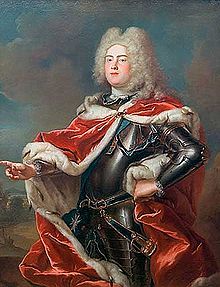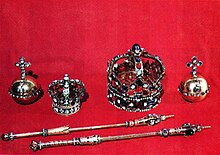Augustan Age (Electorate of Saxony)


The Augustan Age describes an epoch in Saxon history in which the Electorate of Saxony experienced a golden age and in Saxony outstanding products and achievements emerged in the political, cultural and economic fields. It lasted from 1694 to 1763. The time was characterized by excess, exuberance, sensuality, the development of splendor and high culture .
history
The Wettin electors August II and August III. That gave the era its name and duration, ruled simultaneously in personal union as Polish kings. The ruling conglomerate Saxony-Poland was one of the more important powers in Europe. August II tried to raise Saxony to the level of a European great power and pursued a corresponding European great power policy. First of all, Friedrich August I was appointed King of Poland with the free election of 1697 . Then August II attempted further conquests in the Baltic Sea area . This led to military expansion attempts such as the Saxon Livonia Campaign of 1700.
Dresden was greatly expanded by the electors and grew to over 60,000 inhabitants by 1750. A little later it became internationally famous as Florence on the Elbe . The Dresden Picture Gallery rose to become one of the most important art collections in Europe, and the Green Vault also testified to the Wettins' passion for collecting . In 1754 the Sistine Madonna came to Dresden. In addition to the structural work in the royal seat, the court festivals , including the Saturnus festival of the court of Electoral Saxony, became famous. The residential landscape around Dresden was greatly expanded. New pleasure palaces and hunting lodges were built. Opulence and the representation of wealth, representation, exuberance, a strong increase in corruption, and a mistress culture characterized the political culture in the electorate. Top executives from art and culture from all over Europe were hired on a large scale. Antonio Lotti (Hofkapellmeister 1717–1719) and Johann Adolph Hasse (1733–1763) established the tradition of Italian opera. The second Saxon center, Leipzig, also grew rapidly to 35,000 inhabitants by 1750. The economy flourished throughout the electorate.
The ministers Jakob Heinrich von Flemming and Heinrich von Brühl , who collected art himself and had the Brühl terrace built , had great influence . In the period in which the Dresden Baroque experienced its peak and also its replacement by the Rococo , the dawn of classicism , important artists and art scholars worked in Dresden:
- George Bähr , Bernardo Bellotto , Jean de Bodt , Samuel Bottschild , Gaetano Chiaveri , Christian Wilhelm Ernst Dietrich , Heinrich Christoph Fehling , Carl Heinrich von Heinecken , Charles Hutin , Johann Friedrich Karcher
- Wolf Caspar von Klengel , Johann Christoph Knöffel , Johann Gottfried Knöffler , Friedrich August Krubsacius , Wilhelm Krüger , Zacharias Longuelune , Johann Christoph Ludwig Lücke , Lorenzo Mattielli , Anton Raphael Mengs , Ismael Mengs
- Adam Friedrich Oeser , Balthasar Permoser , Matthäus Daniel Pöppelmann , Johann Christoph Rost , Johann Georg Schmid , Gottfried Silbermann , Louis de Silvestre , Johann Alexander Thiele , Stefano Torelli , Johann Joachim Winckelmann
The reigns of August the Strong and August III. were characterized by uninhibited display of magnificence. Many of the buildings that determine the appearance of Dresden's old town today were built during this time. In 1731 there were seven outstanding architectural works in Dresden: the Zeughaus , the Kunstkammer , the Johanneum , the Augustusbrücke , the East Indian Palace at the White Gate in Old Dresden, the Zwingergarten , the Jägerhaus in Old Dresden.
The fate of Countess Cosel was formative for this epoch . After the long-standing and influential mistress fell out of favor with August the Strong , she was taken to Stolpen Castle in 1716 . Although her August III. offered the release, she spent another three decades at the fortress until the end of her life.
Zwinger (built from 1710 to 1728)
Pillnitz Castle (built from 1720 to 1723)
Frauenkirche (built from 1726 to 1743)
Hofkirche (built from 1739 to 1751)
The mayors of Dresden had to protect the interests of the city vis-à-vis the court that extended their powers. In many cases , as with the building of the Frauenkirche , it was also about financial interests. After August the Strong came to power, Gabriel Tzschimmer was initially in office. He was followed by Marcus Dornblüth , Christoph Heinrich Vogler , Burkhard Leberecht Behrisch and Christoph Bormann .
The invention of Meissen porcelain is one of the most famous developments of the Augustan era . August the Strong actually wanted Johann Friedrich Böttger to produce gold. Instead, on March 28, 1709, the invention of porcelain was announced. Instrumental in the development were also Ehrenfried Walther von Tschirnhaus , Jacob Bartolomäi , Michael Nehmitz and Christoph Gottlob Lichtwer . From 1735 led Heinrich von Brühl , the Meissen porcelain factory . The most famous modeller was Johann Joachim Kaendler .
Wars and conflicts
The decades of the Augustan era were less peaceful than the magnificent buildings of Dresden suggest. The first wars, in particular the Great Northern War and the War of the Polish Succession , mostly took place outside of Saxon territory. There were repeated military conflicts, in which the Swedish Empire and Russia were involved, particularly over domination in Poland . The luxurious life at the Saxon court exceeded the economic capacity of the country and was finally financed at the expense of military strength. The Saxon army , which had demonstrated its high performance to an international audience at the Zeithainer Lustlager , had to be reduced from the 1730s. During the first and second Silesian Wars , Saxony suffered severe setbacks in the struggle for supremacy against its northern neighbor, Prussia . The Brandenburg-Saxon relations remained strained. Brühl tried to build an international coalition against Prussia. But Frederick II anticipated this with an initiative attack and occupied the entire electorate in 1756 after the Saxon army had been encircled near Pirna . The Saxon elector fled with the court to Warsaw, where he spent the rest of the war. During this time, Saxony was kept occupied and the scene of bloody battles and sieges. The country suffered severe economic and demographic losses when the Seven Years' War finally ended with the Peace of Hubertusburg in 1763 . With the death of Prime Minister Brühl and August III. the Augustan era ended and a new era began in which economic reconstruction as a rétablissement was in the foreground and the display of splendor and self-presentation was significantly reduced.
Movie
- Saxony's glory and Prussia's glory . six-part television series, television of the GDR, 1985/1987.
literature
- Frank Göse , Winfried Müller, Kurt Winkler, Anne-Katrin Ziesak (eds.): Prussia and Saxony - Scenes of a Neighborhood. Sandstein Verlag, 2014.
- Reiner Groß : History of Saxony. Edition Leipzig, special edition of the Saxon State Center for Political Education Dresden / Leipzig 2012.
- René Hantke : Brühl and the Renversement des alliances: the anti-Prussian foreign policy of the Dresden court 1744–1756. LIT Verlag, Berlin 2006.





